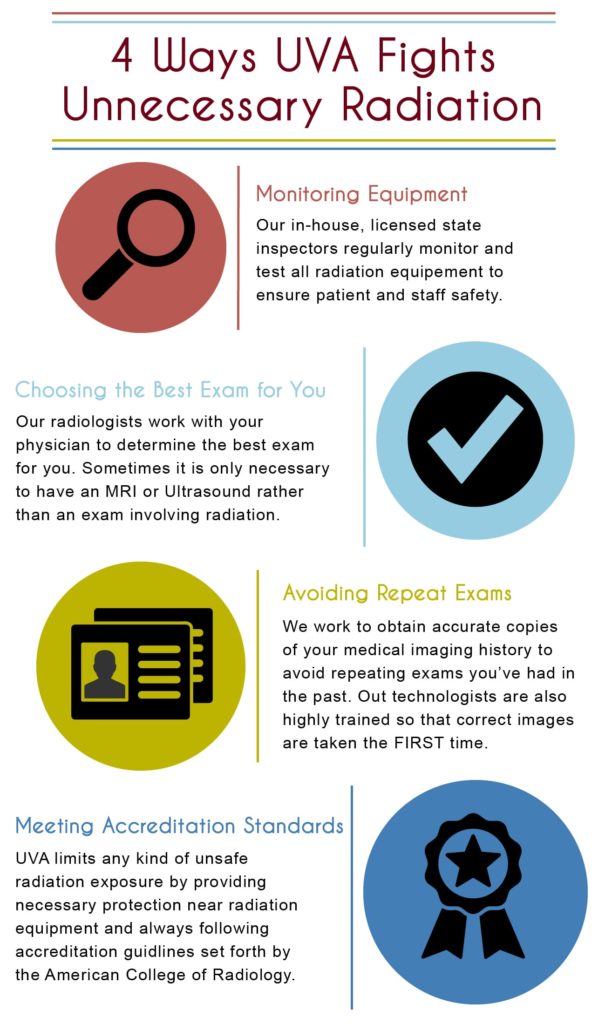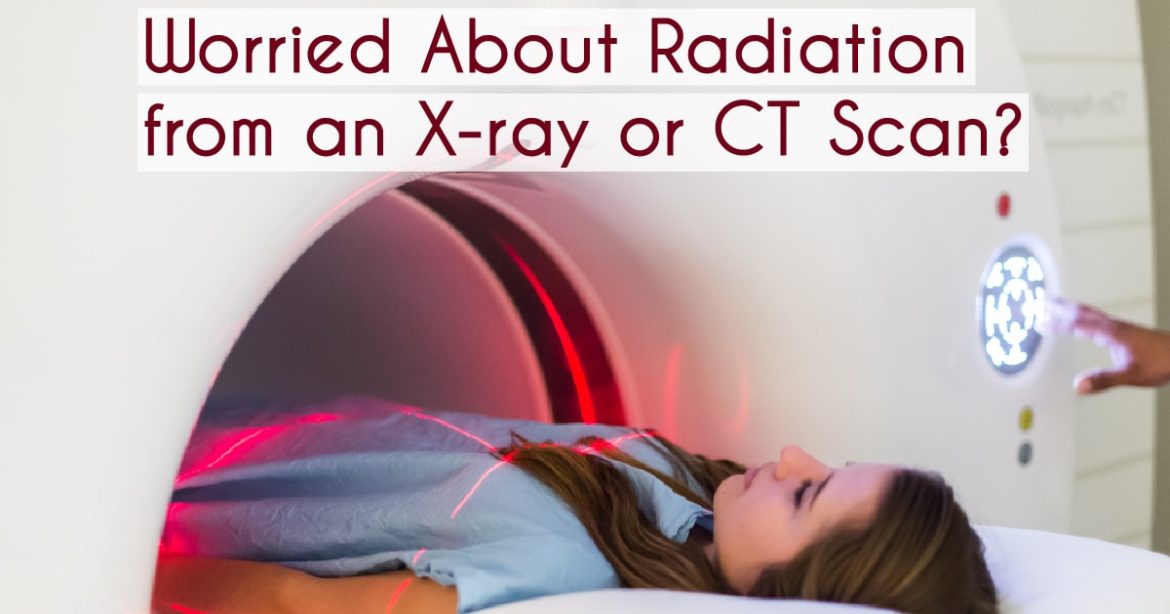Many patients are concerned about receiving radiation from CT Scans or X-rays. Even the word “radiation” can be intimidating, as we often associate it with radiation sickness from atomic bombs or disasters at nuclear power plants. But don’t worry – the radiation used in medical imaging will not make you glow in the dark and will not harm you in small doses. At UVA Radiology and Medical Imaging, we want to free you from any worries you may have about imaging radiation by helping you understand the slight risks involved and the many precautions we take to protect you from any unnecessary radiation.
What is Radiation?
In order to address any concerns you may have about radiation, it is important to first understand what radiation is. Ionizing Radiation is the emission of high-energy electromagnetic waves that move subatomic particles. This type of radiation carries enough direct energy that it causes electrons to detach from atoms or molecules, which is called ionization.
In medical imaging, X-ray technology emits these high-energy waves (similar to light) that pass through the body and generate images of structures within the body. These waves are absorbed in different amounts by different structures of the body. The denser an object in the body is, the more the waves will be absorbed. For instance, x-rays pass easily through soft tissue and organs, but are absorbed by highly dense structures like bones. Because the bones have absorbed most of the waves, they show up as white “shadows” on the radiograph.
Medical imaging exams that use radiation include traditional x-rays, CT, nuclear imaging exams, or fluoroscopy. However, there are other types of imaging exams that use technology that does not emit radiation. MRI and Ultrasound scans do not use radiation at all, and therefore do not pose any increased risk of cancer.
What are the Risks?
Exposure to too much radiation over time could be bad for you, but sometimes small doses are necessary for your well-being. The main risk associated with radiation is its ability for ionization. If exposed to a large amount of radiation in a short period of time, ionization can damage your DNA, which can lead to cancer. However, this has been observed only in survivors of atomic bombings, nuclear accidents, and early x-rays where a large amount of radiation was absorbed in a small period of time.
The dose of radiation you receive in an imaging exam is very low. At this time, there are no published studies that prove medical imaging is a direct cause of increased cancer risk. More often than not, the risk of not having an exam that is important for diagnosing your health issue is greater than the risk of a small exposure to radiation.
Images from exams that use radiation, such as X-ray, CT, nuclear imaging exams, or fluoroscopy, help your radiologist see what is happening inside of you. This helps them make an accurate diagnosis and recommend the next steps in your care. An accurate diagnosis is crucial to the quality of your health care and your well-being for many reasons—the most obvious being that it informs doctor’s decisions in order to properly treat your condition. Good medical images can save lives.
Since the right images are so important to your care, the vast benefits of necessary radiation far outweigh any slight risks. Almost always, when your doctor suggests you have a medical imaging exam that uses radiation, that radiation is necessary. You can always ask your doctor if the test is truly vital for the quality of your care, or check out this lifetime x-ray risk calculator here.
How UVA Fights Against Unnecessary Radiation
At UVA Radiology and Medical Imaging, we work hard to protect you from any unnecessary radiation because, even if small amounts of radiation will not hurt you over time, you should never receive more radiation than you need.
“Unnecessary radiation” refers to any radiation that doesn’t benefit the results of your images, and you could be exposed to it for a number of different reasons.

- For instance, sometimes it is only necessary to have an MRI or Ultrasound rather than a radiation-producing exam. At UVA, our radiologists work with your physician to determine what kind of testing is best for your case so that you do not receive radiation unless it is imperative for your care.
- There is also potential to receive unnecessary radiation from faulty or unsafe equipment. At UVA, our in-house, licensed state inspectors regularly monitor and test all radiation equipment to ensure patient and staff safety.
- At UVA, we are also committed to being as efficient as possible to avoid repeating an exam that you’ve had before. We do so by working with your primary doctor to obtain accurate copies of your medical imaging history to avoid the repetition of any exams you may have had in the past. Our technologists are also highly trained experts in patient positioning and scanning so that the correct images are taken the first time you have an exam.
- UVA Radiology is accredited by the American College of Radiology who documents that our facility is regularly meeting safety requirements for equipment, medical personnel, and quality assurance. UVA limits any kind of unsafe radiation exposure by always following the accreditation guidelines and providing necessary protection near radiation equipment.
X-rays, CT scans, and fluoroscopy are all safer than surgical procedures, despite the small risks that come with radiation. These scans play a critical role in diagnosing patients and determining the next steps in care. Good medical images save lives. The risks associated with them are very small compared to the enormous benefit they provide patients. To learn more about UVA Radiology’s commitment to safety, click here.



